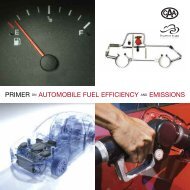Promoting Green Power in Canada - Centre for Human Settlements
Promoting Green Power in Canada - Centre for Human Settlements
Promoting Green Power in Canada - Centre for Human Settlements
- No tags were found...
Create successful ePaper yourself
Turn your PDF publications into a flip-book with our unique Google optimized e-Paper software.
<strong>Promot<strong>in</strong>g</strong> <strong>Green</strong> <strong>Power</strong> <strong>in</strong> <strong>Canada</strong> Pollution ProbeBox 4.10 — Government SupportPays <strong>in</strong> the Long RunEuropean governments have givenstrong supported <strong>for</strong> w<strong>in</strong>d, PV andbiomass over the past two decades,<strong>in</strong>clud<strong>in</strong>g fund<strong>in</strong>g <strong>for</strong> R&D, pilotprojects, and the creation ofmanufactur<strong>in</strong>g capacity. As aconsequence:· biomass <strong>in</strong>dustries <strong>in</strong> F<strong>in</strong>land andSweden are among the mostsuccessful <strong>in</strong> the EU;· Denmark is the world leader <strong>in</strong>w<strong>in</strong>d turb<strong>in</strong>e manufactur<strong>in</strong>g (morethan 50% of the world exportmarket <strong>in</strong> 1999);· Germany has a strong <strong>in</strong>digenousbiomass technology <strong>in</strong>dustry toservice the emerg<strong>in</strong>g domesticmarket; and,· Germany and the Netherlands arelead<strong>in</strong>g solar photovoltaic systemmanufacturers.[EEA 2001, p. 58]development of renewable power and energyefficiency [OAG 2000, p. 29f.]. TheSusta<strong>in</strong>able Development Technology Fund,with $100 million over five years, might playan important role <strong>in</strong> the emerg<strong>in</strong>g renewablessector, but is limited s<strong>in</strong>ce it does not onlysupport renewable energy technologies.Look<strong>in</strong>g at past successes, it becomes apparentthat the dollar amount of support cannotexpla<strong>in</strong> the differences <strong>in</strong> renewable powerdeployment among <strong>in</strong>dustrialized countries.In terms of per capita spend<strong>in</strong>g, Denmark hasfavoured w<strong>in</strong>d energy more than any othercountry. Overall, the U.S. spent more thanthree times the total amount of money onw<strong>in</strong>d power R&D between 1973 and 2000 thanwas spent by the most successful countries,Germany and Denmark, and U.S. researchbudgets were the highest throughout the1990’s [JLS 2001, p. 334]. Still, Danish w<strong>in</strong>dturb<strong>in</strong>e manufacturers now hold 65% of theworld market, whereas the U.S. only has onemajor turb<strong>in</strong>e manufacturer and accounts <strong>for</strong>only 9.2% of the world market [ibid., p. 369].The reasons <strong>for</strong> these differences lie <strong>in</strong> highly<strong>in</strong>consistent fund<strong>in</strong>g <strong>in</strong> the U.S., whileEuropean fund<strong>in</strong>g programs have been farmore stable, research results were shared,and decision-mak<strong>in</strong>g was decentralized, asopposed to the U.S., where decisions weremade centrally and <strong>in</strong>efficient designs weresupported. Utilities and small manufactur<strong>in</strong>gcompanies were closely <strong>in</strong>volved <strong>in</strong> Denmark’sresearch program, participat<strong>in</strong>g <strong>in</strong> fund<strong>in</strong>g,whereas large aerospace corporations thatlater abandoned the w<strong>in</strong>d energy sector weresupported <strong>in</strong> Germany. The focus <strong>in</strong> Denmarkwas on small <strong>in</strong>cremental improvements andsmall-scale demonstration projects, ratherthan radical changes <strong>in</strong> the technology, aswas the case <strong>in</strong> the U.S. [p. 332]. The Danishexperience <strong>in</strong>dicates that a bottom-upapproach <strong>in</strong> research can be far moreefficient than a top-down system <strong>in</strong> whichresearch is carried out without the closeparticipation of utilities and manufacturers.Government purchas<strong>in</strong>g may be the mostneutral “subsidy” to renewable power. It hasbeen very effective <strong>in</strong> creat<strong>in</strong>g demand <strong>for</strong>renewable power throughout Europe and, <strong>for</strong>example, <strong>in</strong> Pennsylvania, where newly builtw<strong>in</strong>d capacities have been quickly bought upby governmental and <strong>in</strong>stitutional buyers[PA 2002d]. The Government of <strong>Canada</strong> hascommitted to purchas<strong>in</strong>g 20% of its electricityconsumption from emerg<strong>in</strong>g renewable lowimpactelectricity by March 31, 2006, underAction Plan 2000 on Climate Change.Whereas subsidies are often seen as unfairwith respect to competition, they cont<strong>in</strong>ueto be paid to conventional energy sources <strong>in</strong>far greater amounts than to renewable power(see e.g., [CEC 2001, p. 36]). To put th<strong>in</strong>gs <strong>in</strong>perspective, conventional sources of energycont<strong>in</strong>ue to receive the vast bulk ofgovernment subsidies. In the EU, total96
















